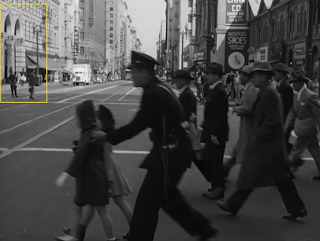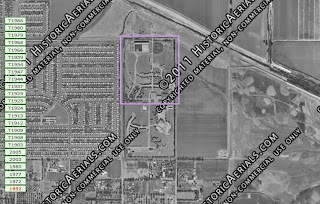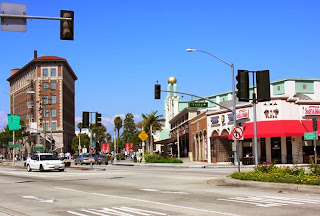Robert Mitchum and Robert Ryan, two classic Hollywood heavyweights, go head to head in the noir The Racket (1951). Ryan is a violent crime boss trying to elect a crooked prosecutor to a judgeship by using his corrupt methods. Mitchum is a police captain who wants to bring Ryan and his racket down. Although the cinematography is not quite as dramatic as some top notch noirs, the strong cast do an excellent job of pushing this crime story along at an active pace. In addition to the superb Ryan and Mitchum, the cast includes other recognizable noir performers such as Lizabeth Scott, Ray Collins, Don Porter, and William Conrad.
The Racket was produced by Howard Hughes when he headed RKO Studios. It was a remake of a film he had produced in 1929 which was an adaptation of a stage play starring Edward G. Robinson and John Cromwell. Hughes selected Cromwell to direct the 1951 film version but was ultimately disappointed with Cromwell's direction. Hughes then brought in director Nicholas Ray to fix the picture. Additionally, Sherman Todd and Tay Garnett were also brought in to film some scenes. Despite a slew of directors and an interfering producer like Hughes, The Racket turned out pretty well.
I don't recall the city is ever named in the film, but I get the impression the story is supposed to be set in New York City. However, filming was actually done in California in downtown Los Angeles, Culver City and Encino. There is even one location with a connection to the popular classic film, It's a Wonderful Life (1946) - keep reading to find out.
Note: Click images to see larger.
DOWNTOWN LOS ANGELES
In this first location a man is killed in a parking lot that was once located on Wilshire Boulevard a couple blocks west of Grand Avenue. As you will see in the next few scene comparisons there are a few structures from the time of the film that are still standing, but overall, this area has vastly changed. The parking lot and the buildings that stood right next to the parking lot are now demolished but the buildings that we see in the background when looking in the direction of Grand Avenue are still there.
Looking down Wilshire Blvd towards Grand Ave.
Looking east from Grand Ave near Wilshire.
The building in green in the background outlined in the purple box is the Los Angeles Jewelery Center located at 629 Hill Street. It's a twelve-story office building that was built in 1930. The building located on the far right of the above image stands on Grand Avenue where Wilshire Boulevard dead ends. You can see more of this building in the below screenshot.
A view of Grand Avenue in background.
Looking at Grand Ave from Wilshire Blvd.
The next screenshot is a closeup of the parking lot where the man is murdered. The parking lot and the building in the background were located behind what was then Dawson's book store. Dawson's used to be at 627 South Grand Avenue at the corner of Wilshire Boulevard. To give a better idea of how this area once looked, below the screenshot of the parking lot there is a vintage photo from 1952 from the Los Angeles Public Library (LAPL) photo collection showing the view of Dawson's book store, the parking lot (see the green box) and the building just behind the parking lot. Today this location is the site of modern glass office towers as can be seen in the contemporary view.
Car lot on Wilshire Blvd one block west from Grand Ave.
Looking west down Wilshire from Grand ca. 1952. Car lot can be seen in the green square. Dawson's book store is on the corner. Photo: LAPL
Contemporary view looking west down Wilshire from Grand.
When some of the crooks are driving downtown they come to a stop at the intersection of 7th Street and Flower Street. In the screenshot below where the traffic officer is helping pedestrians cross the street we get a view looking down 7th Street from the intersection at Flower Street. Although the buildings immediately on the right of the screenshot are demolished the building on the left (in the yellow box) is still standing, as are some other buildings in the background.
Looking down 7th Street from Flower Street.
Looking down 7th Street from Flower Street.
The "7th District Police Station" was really the Los Angeles Central Division Police Station which was located at 318 West 1st Street. Although this building was demolished long ago, I recognized the stonework entrance from digging through old photos for another project. In the next three images we see 1) a screenshot of Ryan entering the police station, 2) an LAPL photo from 1936 showing a full shot of the Central Division Police Station and how it once looked, and 3) a contemporary view of the corner of 1st Street and Hill Street revealing the vacant lot where the police station once stood.
Ryan enters the Central Division station at 318 W. 1st St.
Central Division police station 1936. Photo: LAPL
318 W. 1st Street. Central Division demolished.
In the scene where Ryan enters the police station below, we get a glimpse of the Hill Street Tunnel in the background. The Hill Street Tunnel was made up of two tunnels that at one time allowed trolleys and automobiles to enter/exit downtown Los Angeles. This view is of the south side of the Hill Street Tunnel. In another noir, Criss Cross (1949) starring Burt Lancaster, Yvonne DeCarlo and Dan Duryea, we get a view of the north end of the Hill Street Tunnel. A few years after the making of The Racket the Hill Street Tunnel and the surrounding buildings would be demolished for future developments.
Ryan enters the Central Division Station. The edge of the Hill Street Tunnel can be seen in the background.
Hill Street Tunnels being deconstructed in 1955. Photo: LAPL
Contemporary view of Hill Street from 1st Street. Tunnels demolished.
This last downtown Los Angeles location is just another view of 1st Street outside of the Central Division Police Station. This view is of 1st Street looking in the direction of Broadway. You can see from the comparison below that the buildings on the right towards the front are all demolished, however, in the background we get a glimpse of the historic Los Angeles Times Building which is still standing. When the Los Angeles Times Building opened in 1935 it was the largest building in the western U.S. designed and occupied entirely for the purpose of a daily newspaper publishing operation.
Looking down 1st Street towards Broadway. The Los Angeles Times building can be seen in the background on the right.
Looking down 1st St. towards Broadway. LA Times building still standing.
The It's a Wonderful Life (1946) connection.
THE RKO ENCINO RANCH
During one scene Mitchum visits the home of a friend and warns him not to cause trouble in his precinct. As Mitchum leaves the home a bomb explodes on the front porch. At first I had no idea where this home might be located, but I figured as this was an RKO film, that maybe they might have filmed the scene on their ranch property out in Encino. Eventually I found a screenshot from that popular film starring Jimmy Stewart, It's a Wonderful Life, on the amazing website Retro Web, and I recognized a few details from the house used in It's a Wonderful Life as being the same in the house used in The Racket. It's already known that It's a Wonderful Life was filmed on the RKO Encino Ranch so now I can confirm that The Racket also filmed on the RKO Encino Ranch. The home used in The Racket was the building used as "Ma Bailey's Boarding House" in It's a Wonderful Life. I've highlighted in purple details on the windows and the front porch columns on the screenshot from The Racket and on the image from It's a Wonderful Life so you can see how the two match up. By the way, if you have not visited the Retro Web site I recommend jumping on over. They have numerous images of different Los Angeles area studio buildings and other fun stuff to check out.
Mitchum leaves a house on the RKO Encino Ranch.
Mitchum stands inside a house located on the RKO Encino Ranch.
The RKO Encino Ranch was bounded by Burbank Boulevard to the South, Louise Ave to the West, Oxnard Street to the North and stopped at where the Balboa Park begins, just before Balboa Boulevard to the East. Below is a vintage aerial view of the RKO Encino Ranch showing where the residential neighborhood used for the scene where the bomb goes off in The Racket and where It's a Wonderful Life were both filmed. The purple box in the next three images shows the exact area where this part of the ranch set was located. 1) Vintage aerial of RKO Encino Ranch sets, 2) Vintage 1952 aerial view of Encino (see purple box for RKO ranch, and 3) an aerial view of Encino from 2013 (purple box outlines the former site of the RKO sets).
Aerial view of the RKO Encino Ranch.
Vintage 1952 aerial view of the ranch.
A contemporary view marking the site of the former RKO Encino Ranch.
CULVER CITY
Near the end of the film there is a chase scene between the police and Ryan who is attempting to get away. The chase cuts right through the heart of Culver City. You can tell I've forced my wife to sit through a lot of old movies because even she yelled out during the scene below, "that looks like the Culver Hotel." And indeed it is the historic Culver Hotel located at 9400 Culver Boulevard.
During the chase the cars race down the part of the street between the Culver Hotel and what is today a Pacific Theatre and then continues pass the site of the historic Culver Studios. The stretch of street between the Culver Hotel and the Pacific Theatre is now closed off to traffic but it is still open in the area in front of The Culver Studios.
The Culver Hotel in Culver City. 9400 Culver Blvd.
Looking east down Culver Blvd towards the Culver Hotel. Source.
Buildings located across from Culver Hotel, between Van Buren Place and the Culver Studios.
New buildings stand in the place of the ones that were once located across from the Culver Hotel.
Today, directly across from The Culver Studios is the location of a large parking lot. When The Racket was filmed we can see that there used to be many different commercial buildings that once stood at this location. In the next three images we see: 1) screenshot from The Racket showing the Chop Suey restaurant, liquor store and other buildings that used to be located on the site of the parking lot, 2) a vintage view from the LAPL showing the same buildings (but looking the opposite direction towards the Culver Hotel), and 3) a 2013 view showing the parking lot where the buildings seen in The Racket once stood.
Buildings located across the street from the Culver Studios.
A vintage view of buildings across from the Culver Studios. This view looks west towards the Culver Hotel. Photo: LAPL
The buildings across the Culver Studios and the Culver Hotel are now demolished and is the site of a parking lot.
Aerial view of the Culver City chase scene location.
The above aerial view shows the location of the chase scene through Culver City. The bright yellow arrow marks the path that the cars take when they pass The Culver Hotel and The Culver Studios. The orange box marks the parking lot where the Chop Suey restaurant and liquor store once stood.
To use a baseball expression, The Racket may not be a grand slam, but it at least pounds a double with Mitchum and Ryan heading the picture. The great locations make the film all the more enjoyable to watch. The Racket is available on DVD, can be rented through ClassicFlix and Netflix, and is currently available for streaming on Warner Archive Instant.
Your thoughts?

































+With+Burt+Lancaster+in+I+Walk+Alone+(1948).jpg)
+Technicolor+madness+in+Desert+Fury+(1948).jpeg)
+With+Bogart+in+Dead+Reckoning+(1947).jpeg)
.jpeg)
